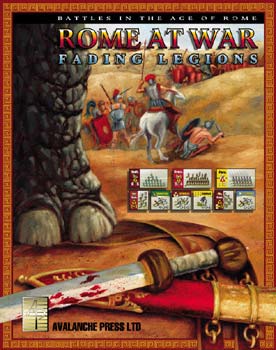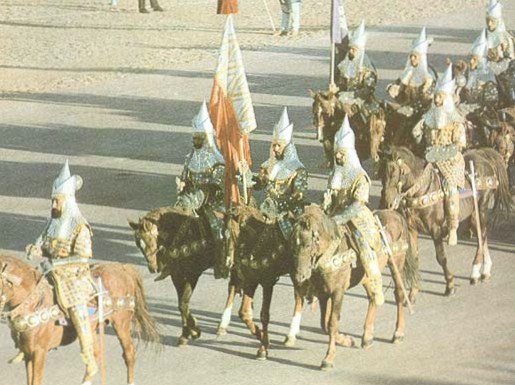| Princes of Persia:
Part III: Sassanid Glory and Downfall
By David Meyler
April 2018
 In the 150 years after Shapur’s death in 379, intermittent wars with Rome and the Huns continued. There were 11 shahs during this period, most having short reigns, with a long period of intermittent internal unrest. This began with the disputed reign of Hormizd III in 457-459, who seized the throne while his elder brother Peroz was in Bactria. Peroz returned with the military support of the White Huns and deposed this brother (who was either put to death by Peroz or pardoned depending on the source). Peroz was later killed fighting against the White Huns. In the 150 years after Shapur’s death in 379, intermittent wars with Rome and the Huns continued. There were 11 shahs during this period, most having short reigns, with a long period of intermittent internal unrest. This began with the disputed reign of Hormizd III in 457-459, who seized the throne while his elder brother Peroz was in Bactria. Peroz returned with the military support of the White Huns and deposed this brother (who was either put to death by Peroz or pardoned depending on the source). Peroz was later killed fighting against the White Huns.
Balash then became Shah, but he was deposed by his nephew and son of Peroz, Khavad I. He first ruled from 488 to 496, but was then deposed by the nobility for his support of the Mazdaki communistic sect. His brother Djamasp was put on the throne, but Khavad escaped to the White Huns, and with their support, returned in 498. His later rule proved effective, although he had to continue to pay tribute to the Huns.
A joint Persian-Hun army under Kavadh, invaded Roman territory. In 502 he took Theodosiopolis in Armenia; in 503 Amida on the Tigris. In 505 an invasion of Armenia by the western Huns from the Caucasus led to an armistice, during which the Romans paid subsidies to the Persians for the maintenance of the fortifications on the Caucasus.

Sassanid re-enactors honor a latter-day King of Kings at Isfahan in the late 1970's.
Emperor Justin I (518–527), when he came to the throne, renewed the war. His Arab vassal, al-Mundhir IV ibn al-Mundhir, raided deep into Mesopotamia and destroyed Christian churches and slaughtered monks and nuns. After 527, the new emperor, Justinian I, appointed Belisarius to command the imperial army in the east. This so-called “Last of the Romans” quickly proved himself an able and effective commander, defeating the larger Sassanid army through superior generalship. In June 530, he led the Romans to a stunning victory over the Sassanids in the Battle of Dara, followed by a close defeat at the Battle of Callinicum on the Euphrates in 531. Shortly afterwards Kavadh died, at the age of eighty-two, in September 531.
Civil war resulted between two sons of Kavadh, Khosrau and Kawus. Kawus was supported by the Mazkadites, considered heretics by the Zoroastrian magi priesthood. Khosrau was supported by the nobles and the magi. Khosrau won in battle in 532, and Mazdak and many of his supporters were executed. A Pax Perpetuum or “eternal peace” between the Persians and Romans was signed in 532, with Rome to pay an annual tribute.
Eternal peace lasted eight years. In 540, Khosrau invaded Syria and sacked Antioch. Belisarius returned, besieged Nisibis, but could not take the city and was then recalled to the west. Khosrau in turn unsuccessfully besieged Edessa, but the garrison proved too strong and he had to retreat. Many years of campaigning followed, interspersed with truces, with campaigning in Syria, Mesopotamia and Armenia, but neither empire could gain a decisive advantage. A peace treaty with the Romans in 561 allowed Khosrau to turn east. In alliance with a new power, the Turks, he decisively defeated the White Huns. The Turks then sent an embassy to the Romans to ally against the Persians, but nothing came of the offer. Khosrau also campaigned against the Arabs in Yemen.
Khosrau is another of the great Sassanid monarchs, and represents the epitome of the philosopher king. Upon his ascension to the throne, Khosrau did not restore power to the feudal nobility or the magi. He reformed the tax system which allowed for a centralized bureaucracy to function, and to pay for an army that was no longer under the control of local magnates.
A university was established at Gundeshapur, where Greek, Indian and native Persian philosophy and science were studied. Advances were made laying the foundation of modern medicine. The first hospital where separate wards were established based on pathology was built. He initiated many public works projects, building or rebuilding roads and bridges, and securing the east-west trade routes, disrupted by years of warfare and neglect, what is known as the Great Silk Route. No less important was the Spice Route to India and south-east Asia. It was also at this time that chess was introduced from India, while Persian backgammon was brought to India.
Khosrau died in 579 after a 58-year reign, in the midst of new treaty negotiations with Rome. Hormizd IV, a son, took the throne after killing off his rival brothers. He enforced a tough discipline in his army and the state at large, but also ensured religious toleration was followed, claiming he could not rule unless he had the good will of all the people. War with Rome, meanwhile, continued. Hormizd’s autocratic manner finally resulted in revolt led by the general Bahram in 590 (victor over the Turks the year before). Hormizd was defeated, captured, blinded and murdered.
His son Khosrau II was put on the throne. He ruled as Shah to 628, and in military terms at least, was one of greatest Sassanid rulers. His armies reached to the limits of the ancient Achaemenid empire, reaching the Mediterranean coast and taking Egypt in 616. But the conquests proved ephemeral. Constantinople itself was besieged, but the Roman Emperor Heraclius allied with the Khazars and held off the Persians for ten years.
Then in 626, the Romans counter-attacked and reached the Persian capital. In the wake of these defeats, Khosrau was deposed by the army in favour of his son Khavad II. After putting his father and 18 brothers to death, Khavad himself suddenly died. Ardashir III, a boy of seven, ruled for less than two years before he in turn was deposed and killed by the generals.
Farrokhan, the Eran Spahbod (Commander of the Army) and Shahrbaraz (Boar of the Empire), who had led the successful campaigns against the Romans, then took the throne in his own name. He could not stop the incursions of the Khazars, however, and was in turn killed in 630. There followed two brief reigns in succession by two daughters of Khosrau, Purondokht and Azarmidokht, the only time in its long history that women ruled the Persian Empire. Although some partly successful reforms were begun, internal dissension continued, and the son of Farrokhan, Rostam (appointed as Eran Spahbod by Purondokht), had Azarmidokht blinded. The short reigns of Hormizd VI and Khosrau IV followed. A grandson of Khosrau II, Yazdegerd III finally re-established some internal calm in 632.
A major Arab invasion began in 633. The Arab army, all volunteers led by Khalid ibn al-Walid, was successful in four major battles and captured most of Mesopotamia. Persian counter-attacks in 634 and 635 were successful. A decisive campaign was planned for 636, in alliance with their old Roman enemy, Emperor Heraclius. The Roman army was slaughtered in August in Syria at the battle of Yarmuk, while the Persians, who moved too late, were destroyed in November at the four-day battle of Qadisiyya on the Euphrates River. The fighting had been hard and inconclusive until Rostam was killed and the Persian army fell apart (many veterans had already been lost in 633, 34 and 35).
The Sassanids never recovered from the loss of Mesopotamia. Another counter-attack in 641 failed. Under the third Caliph, Uthman, the Persian heartland itself was invaded. In 653, Yazdegerd III was killed and Sassanian rule came to an end.
Postscript
A daughter of Yazdegerd, Shabanu, (at least according to some sources), was married to Husayn ibn Ali, and was mother of Ali the Martyr. His other daughter, Izdundad, married Bostanai, exilarch (leader) of the Jewish community in Persia. The ancestry of Bahá'u'lláh, the Bahá'í religious leader, can be traced back to Yazdegerd.
Peroz, the eldest son of Yazdegerd, and much of the imperial family escaped through the Pamir Mountains in what is now Tajikistan and arrived in Tang China. Peroz, technically Peroz II, Sassasanian emperor in exile, asked for military help from the Tang Emperor Gauzing against the Arabs in 661. The Tang court created the Area Command of Persia at what is now Saran in Afghanistan, with Peroz as commander-in-chief. The sister of the Sassanian prince was married to the Chinese emperor, who allowed Sassanian refugees fleeing from the Arab conquest to settle in China.
Peroz never made it back to Persia. His son, Narsieh, in turn was given a military command in the Chinese imperial army. He married a princess of the Tang imperial family and his descendants adopted the imperial name of Li. In the 9th century, the family held rights to the title of Military Governor of Guangzhou.
Re-fight the battles of Rome and Persia in Rome at War: Fading Legions!
|
